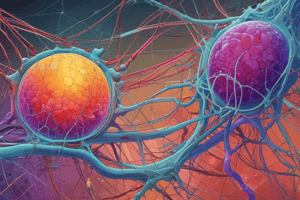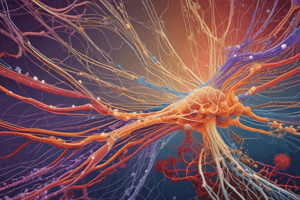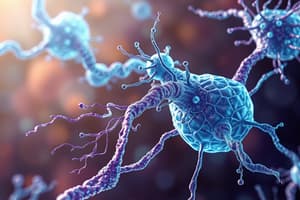Podcast
Questions and Answers
What is the primary function of the cytoskeleton?
What is the primary function of the cytoskeleton?
to give the cell its shape and mechanical resistance to deformation
What are the three main components of the cytoskeleton?
What are the three main components of the cytoskeleton?
microfilaments, intermediate filaments, and microtubules
What are the structural features of the cytoskeleton in eukaryotic cells?
What are the structural features of the cytoskeleton in eukaryotic cells?
It extends from the cell nucleus to the cell membrane and is composed of similar proteins in various organisms
In what cellular processes is the cytoskeleton involved?
In what cellular processes is the cytoskeleton involved?
What are some examples of specialized structures formed by the cytoskeleton?
What are some examples of specialized structures formed by the cytoskeleton?
Explain the structure and composition of microtubules in eukaryotic cells.
Explain the structure and composition of microtubules in eukaryotic cells.
What are the main functions of microtubules in cellular processes?
What are the main functions of microtubules in cellular processes?
How are microtubules nucleated and organized in eukaryotic cells?
How are microtubules nucleated and organized in eukaryotic cells?
What are the dimensions of microtubules and their inner diameter?
What are the dimensions of microtubules and their inner diameter?
Discuss the involvement of microtubules in intracellular transport and cellular processes.
Discuss the involvement of microtubules in intracellular transport and cellular processes.
Flashcards are hidden until you start studying
Study Notes
Cytoskeleton Overview
- The primary function of the cytoskeleton is to provide structural support, shape, and mechanical resistance to cells.
Components of the Cytoskeleton
- The three main components of the cytoskeleton are microtubules, microfilaments, and intermediate filaments.
Structural Features of Cytoskeleton in Eukaryotic Cells
- In eukaryotic cells, the cytoskeleton is composed of a network of filaments that crisscross the cytoplasm.
- The cytoskeleton is dynamic and can be reorganized in response to changes in the cellular environment.
Cellular Processes Involving Cytoskeleton
- The cytoskeleton is involved in cellular processes such as cell division, cell signaling, cell migration, and intracellular transport.
Specialized Structures Formed by Cytoskeleton
- Examples of specialized structures formed by the cytoskeleton include cilia, flagella, and the spindle fibers involved in mitosis.
Microtubules in Eukaryotic Cells
Structure and Composition
- Microtubules are hollow cylindrical structures composed of tubulin dimers (α-tubulin and β-tubulin).
- The outer diameter of microtubules is approximately 25 nanometers, with an inner diameter of 15-17 nanometers.
Functions of Microtubules
- Microtubules provide structural support, shape, and mechanical resistance to cells.
- Microtubules are involved in intracellular transport, cell division, and cell signaling.
Nucleation and Organization of Microtubules
- Microtubules are nucleated and organized by the microtubule-organizing center (MTOC) in eukaryotic cells.
Involvement in Intracellular Transport and Cellular Processes
- Microtubules are involved in the transport of vesicles, organelles, and proteins throughout the cell.
- Microtubules also play a role in the separation of chromosomes during cell division.
Studying That Suits You
Use AI to generate personalized quizzes and flashcards to suit your learning preferences.




